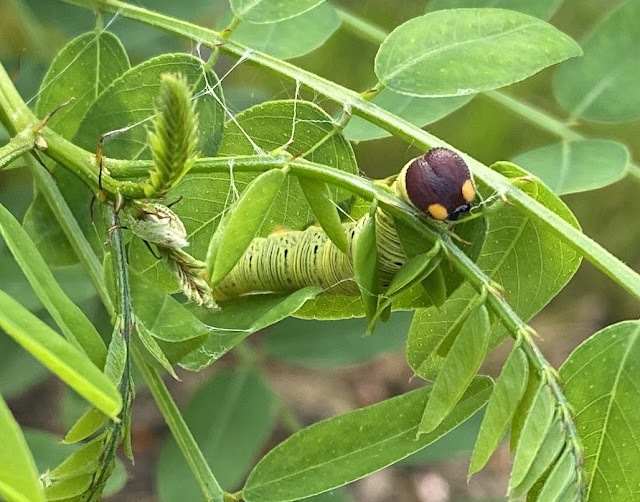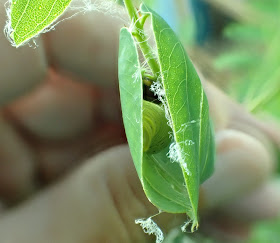We got this picture from our neighbor, Cyrus, who found who found these caterpillars crawling all over his false indigo bush, Amorpha fruticosa. He had already identified them as silver-spotted skipper larvae, a species I hadn't seen before. When they moved in next door two years ago, he plunged into nature immediately, replacing foundation plantings with native species and reporting lots of backyard insect finds. He is helped by 3 year old Cobie who is curious and built close to the ground where she is eye level to many of their new plantings. Among other finds she spotted were these predatory stink bug eggs.
The silver-spotted skipper (Epargyreus clarus) is one of the largest skippers, readily identified from a distance by its distinctive white patch on the lower side of its folded wing. Adults have a long "tongue" (proboscis) and feed on nectar from a variety of flowers as well as puddling on moisture and the odd dung droppings.
 |
| Early instar SSS caterpillar |
As usual, the University of Florida has extensive information on the SSS.
"Like most skippers, silver-spotted skipper larvae live in leaf shelters.
First instar larvae make shelters on the apical halves of leaves by
cutting a flap on the leaf margin, folding it over and attaching it with
silk. Larger larvae often silk several leaves together to form
shelters. During development, the larvae make four distinct types of
shelters (Lind et al. 2001, Weiss et al. 2003). They leave the shelters
only to feed or to make larger shelters." entnemdept.ufl.edu
 |
| Leaf shelter |
Cyrus located some leaf shelters and help me to photograph them as well as get a video of this rather annoyed caterpillar in its leaf nest. Once we were through we taped the little branch onto the shrub so it could settle in for the night.
"Insect frass may provide chemical cues for parasitic wasps to the
location of prey insects (Weiss 2006). Many caterpillars that live in
leaf nests, including the silver-spotted skipper, forcibly eject their
frass for considerable distances to eliminate these chemical cues.
Silver-spotted skipper larvae utilize their anal comb to throw their
frass a distance up to 38 body lengths (Weiss 2003)." entnemdept.ufl.edu
 Introducing a child to nature before they have learned to fear all insects is a great way to create a naturalist for life. Cobie has learned to raise and release butterflies and find things in nature. When I last saw her she was out in back "searching for cats."
Introducing a child to nature before they have learned to fear all insects is a great way to create a naturalist for life. Cobie has learned to raise and release butterflies and find things in nature. When I last saw her she was out in back "searching for cats."



